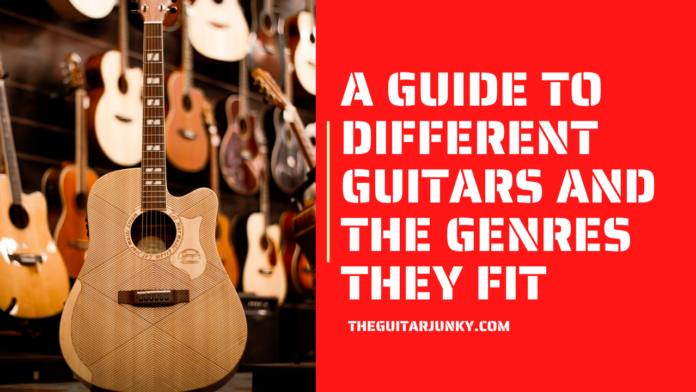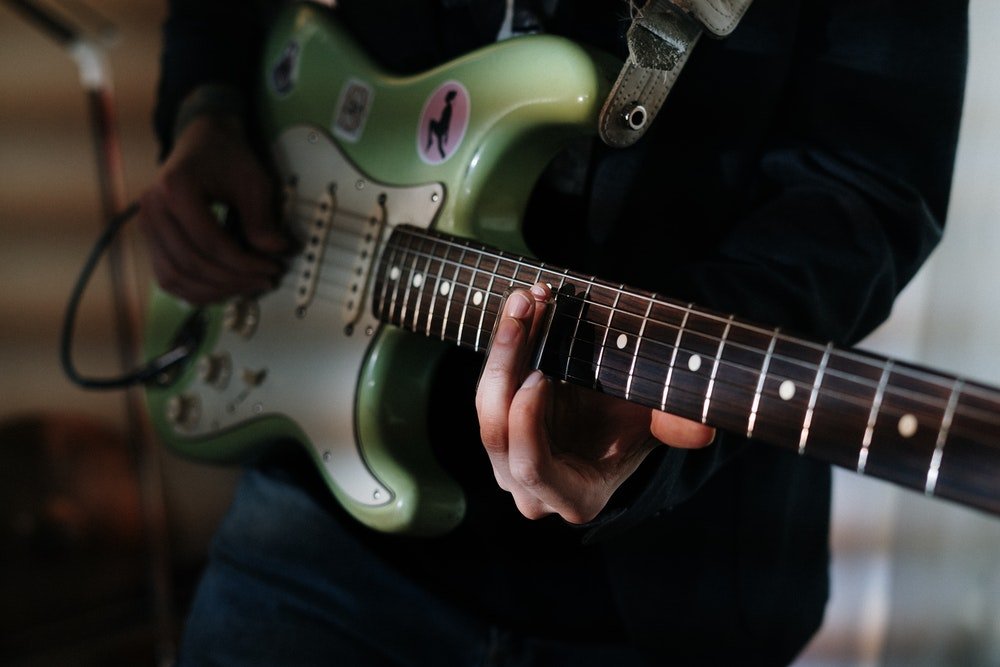Much like various aspects of the music world, guitars are ever-evolving.
Even if today’s music fans have shifted into newer styles of pop, hip-hop, and rap, it doesn’t undermine the timelessness of the guitar — it has influenced such a wide span of genres and music types, both old and new.
Gibson still sells 170,000 guitars a year across 80 countries, while Fender launched a subscription service for online lessons a few years ago.
The company saw a 14% growth in sales since then.
Needless to say, guitars will continue to thrive alongside innovations in music genres.
There are thousands of brands and models available in the market today, and different genres often have a specific type of guitars suited for them.
With this guide, we’ll help musicians like you figure out what guitar will best suit your needs and the type of music you want to play.
Contents
Acoustic Guitars
Acoustic guitars are probably what you’ll picture first when you listen to classical, folk, or country music.
An acoustic guitar is able to deliver standalone volume without the need for plugging it in, as compared to its electric counterpart.
Most acoustic guitars nowadays are made out of various timbers or modern wood substitutes such as high-pressure laminate.
Depending on the wood type, acoustic guitars can have different tones and colors. Mahogany, rosewood, and maple tend to sound warm and mellow, while woods like alder and walnut are stronger and fuller.
Better quality woods can sustain notes for longer periods of time than cheaper woods, sound richer, and also age really well.
For example, the classic dreadnought guitar is a great all-rounder that can suit folk and bluegrass, and it also delivers a quality finger-picked response.
Large-size guitars such as the Gibson J-200 are great for delivering a big strumming noise.
Nylon-string Acoustic
The Spanish or classical guitar is best suited for campfire singsongs and mariachi bands.
A lot of guitarists will have learned to play using a nylon-string guitar.
These come in various sizes and are even suited for younger ages and beginners, as it has a wide fretboard, and the low-tension nylon strings are more forgiving than your regular steel strings.
The overall tone of this guitar is soft and mellow.
Steel-string Acoustic
The most popular body types for steel-string guitars are dreadnought, parlor, and jumbo.
There are also travel guitars that are becoming more popular to guitarists with small hands — singer Ed Sheeran is well known for his preference for smaller models like the travel guitar.
The steel-string acoustic guitar has a brighter tone, which makes it a great versatile choice for pop, country, blues, and folk music.
Besides Ed Sheeran, another artist often seen performing with steel-string acoustics is Taylor Swift.
The Gibson J-180 steel-string acoustic guitar is one of her most trusted guitars and works perfectly with the indie-folk genre of her new albums.
Acoustic Electric
Acoustic electrics are essentially your regular acoustic guitar that can be plugged into an amplifier.
Brands like Fishman and L.R. Pickup types range from a piezo strip hidden beneath a guitar’s bridge saddle, a sensor attached to the underside of the guitar’s surface, or a tiny microphone pointed towards the strings from the inside of the body.
This type of guitar is great when you need more volume, and are excellent for live performances, playing in a band, or for delving into genres that call for guitar effects and pedals.
Electric Guitars
An electric guitar is popular among punk, rock, or metal artists. Various electric guitars are now available on the market, with brands like Fender, Ibanez, and Gretsch manufacturing some of the more popular models.
For instance, Fender’s Stratocaster is one of the most versatile series that can fit beginner to professional players.
The style is timeless and its candy colors are recognizable on any stage.
These guitars are able to handle extensive customizations and effects and offer a wide range of options.
Electric guitars can also be used in almost any music style because of two reasons: the guitar’s body type and pickups can affect its tone, and the gear you plug into can shape its sound as well.
Pedals are also commonly used to switch tones, making electric guitars extremely versatile.
Hollow and Semi-hollow
Hollow and semi-hollow bodied electric guitars feature a sound box inside and have at least one pickup.
The space inside provides a rounder, fuller tone, making it a perfect choice for blues and jazz guitarists. The Gibson ES-335 is a popular model for this genre of music because it adds a warm, vintage character to your overall sound.
Solid Body
When it comes to rock, many of its biggest bands and legends used solid-body models — and most guitarists nowadays are also likely to own at least one solid-body guitar.
These guitars are tougher, easier to transport despite their weight, and are surprisingly comfortable to play.
Great rock guitars respond well to overdrive and often sound great despite drive and distortion effects common to the genre.
The Beatles were big fans of the Epiphone Casino, and it’s been used on some of the greatest rock songs of all time. These guitars are suitable for today’s top music genres such as pop, alternative rock, and indie.
Bonus: Bass Guitars
A different instrument altogether, bass guitars typically feature a solid-body construction with 4 steel strings — although there are other builds and string numbers available as well.
Much like electric guitars, a bass can be used for most music styles. If there’s a guitar featured in a song, a bass guitar is most likely complementing its sound.
Although funk and jazz have some of the most prominent bass inclusions in music, plenty of newer genres enjoy a bass line that slaps too.
Conclusion
We’ve covered some of the best guitar types suited for different genres from rock, pop, folk, to jazz.
Some are more versatile than others, and everyone’s ‘ideal’ guitar type may vary according to their music preference.
Don’t be afraid to try out as many different guitars as you need to, so you can get a good feel of its playstyle and sound before making a decision.



